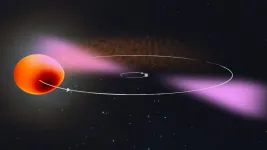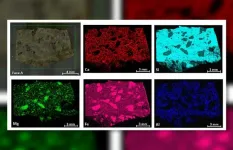"Ghost particle" ML model permits full quantum description of the solvated electron
2021-02-03
(Press-News.org) The behavior of the solvated electron e-aq has fundamental implications for electrochemistry, photochemistry, high-energy chemistry, as well as for biology--its nonequilibrium precursor is responsible for radiation damage to DNA--and it has understandably been the topic of experimental and theoretical investigation for more than 50 years.
Though the hydrated electron appears to be simple--it is the smallest possible anion as well as the simplest reducing agent in chemistry--capturing its physics is...hard. They are short lived and generated in small quantities and so impossible to concentrate and isolate. Their structure is therefore impossible to capture with direct experimental observation such as diffraction methods or NMR. Theoretical modelling has turned out to be as challenging.
Density functional theory (DFT) is the electronic structure method most often used to study the solvated electron and water. Standard density functionals suffer from delocalization error though, making it impossible to model radicals accurately. Pure water complicates DFT approximations considerably, though choosing the right functionals can lead to acceptable results compared to high-level electronic structure benchmarks and values that can be observed through experiment. An accurate description of liquid water can be also achieved with many-body quantum chemistry methods, but they are extremely expensive.
Though a recent picosecond-scale molecular dynamics-based breakthrough unprecedented in complexity and requiring computational resources at the limits of what's possible provided a crucial argument in favor of a cavity structure for e-aq, it did not result in other new insights or in a complete statistical description. Comprehensive characterization of the system's properties requires far longer timescales, but simulating quantum nuclei at this level of electronic structure theory is currently beyond computational reach.
The modern way of working around this problem involves the use of machine learning. Training an ML force field or potential energy surface (PES) based on ab initio data allows for much longer MD simulations because the cost of evaluating such energies and forces is almost negligible compared to that associated with electronic structure calculations. The problem is that the solvated electron is a non-typical species. It doesn't have an atomistic formula, which poses a problem because machine learning PES work with atomistic representations.
In the paper Simulating the Ghost: Quantum Dynamics of the Solvated Electron, University of Zurich researcher Vladimir Rybkin, doctoral student Jinggang Lan and lecturer Marcella Iannuzzi combined their expertise in electronic structure and solvated electrons with the knowledge of EPFL professor Michele Ceriotti and his former PhD students Venkat Kapil, now a researcher at Cambridge University, and Piero Gasparotto, now a researcher at Empa, in machine learning and quantum dynamics. That, with the contributions of other colleagues, resulted in the application of the ML approach to data acquired from a many-body quantum chemistry method known as second-order Møller-Plesset perturbation theory (MP2), a method that gives an accurate description of water, anyway, without any special treatment of the excess electron.
They were surprised to discover that the model was able to learn the presence of the solvated electron as a factor that distorted the structure of the pure liquid water. The dynamics run with the resulting ML PES was not only able to recover the stable cavity, but could also trace the correct localization dynamics, starting from the delocalized excess electron added to the water. In the end, ML simulated the electron as a sort of "ghost particle" that was not explicitly present in the model.
This allowed the researchers to achieve a time scale of several hundred picoseconds and collect reliable statistics by running a lot of computationally cheap classical trajectories and compute vibrational spectra, structures and diffusion. The ML approach also allowed them to simulate the quantum rather than classical nuclei with path-integral molecular dynamics (PIMD). This technique is at least one order of magnitude computationally more expensive than classical MD and cannot be carried out without ML PES at a high level of electronic structure theory.
Taking the nuclear quantum effects into account delivered accurate vibrational spectra, allowing the researchers to quantify the impact of these effects--already shown to be very important in the relaxation dynamics of the excess electron--on the hydrated electron. It also revealed transient diffusion, an unusual, rare event that is not present in the classical regime. While non-transient diffusion of the solvated electron is achieved by solvent exchange followed by gradual displacement of the "electron cloud" or spin density distribution, transient diffusion is rather a jump of the spin density from the stable cavity to the adjacent one.
While the ghost particle approach was applied here to the solvated electron, it could also be applied to excited states and quasiparticles such as polarons, opening up new opportunities for uniting high-level electronic structure theory with machine learning to achieve highly accurate dynamics simulations at a moderate price.
INFORMATION:
ELSE PRESS RELEASES FROM THIS DATE:
2021-02-03
An international research team including members from The University of Manchester has shown that a rapidly rotating neutron star is at the core of a celestial object now known as PSR J2039?5617
The international collaboration used novel data analysis methods and the enormous computing power of the citizen science project Einstein@Home to track down the neutron star's faint gamma-ray pulsations in data from NASA's Fermi Space Telescope. Their results show that the pulsar is in orbit with a stellar companion about a sixth of the mass of our Sun. The pulsar is slowly but surely evaporating this star. The team also found that the companion's orbit varies slightly and unpredictably over time. Using their search ...
2021-02-03
Consider for a moment a tree swaying in the wind. How long does it take for the movement of a twig to reach the trunk of the tree? How is this motion actually transmitted through the tree? Researchers at the University of Freiburg are transferring this kind of question to the analysis of proteins - which are the molecular machinery of cells. A team of researchers lead by Prof. Dr. Thorsten Hugel of the Institute of Physical Chemistry, and Dr. Steffen Wolf and Prof. Dr. Gerhard Stock of the Institute of Physics are investigating how the signals that cause structural changes in proteins travel from one site to another. They are also trying to ...
2021-02-03
Washington, DC / New Delhi, India - Researchers at CDDEP have released, The State of the World's Antibiotics in 2021, which presents extensive data on global antimicrobial use and resistance as well as drivers and correlates of antimicrobial resistance, based on CDDEP's extensive research and data collection through ResistanceMap, a global repository that has been widely used by researchers, policymakers, and the media.
Since the first State of the World's Antibiotics report in 2015, antimicrobial resistance has leveled off in some high-income countries but continues to rise in many low- and middle-income countries (LMICs), where access to antibiotics has risen with increases in gross ...
2021-02-03
Researchers have found new evidence that global warming is affecting the size of commercial fish species, documenting for the first time that juvenile fish are getting bigger, as well as confirming that adult fish are getting smaller as sea temperatures rise. The findings are published in the British Ecological Society's Journal of Applied Ecology.
The researchers from the University of Aberdeen looked at four of the most important commercial fish species in the North Sea and the West of Scotland: cod, haddock, whiting and saithe. They found that juvenile fish in the North Sea and on the West of Scotland have been getting bigger while adult fish have been getting smaller. These changes ...
2021-02-03
The world's largest bird, the ostrich, has problems reproducing when the temperature deviates by 5 degrees or more from the ideal temperature of 20 °C. The research, from Lund University in Sweden, is published in Nature Communications.
The results show that the females lay up to 40 percent fewer eggs if the temperature has fluctuated in the days before laying eggs. Both male and female production of gametes is also negatively affected.
"Many believe that ostriches can reproduce anywhere, but they are actually very sensitive to changes in temperature. Climate change means that temperatures will fluctuate even more, and that could be a challenge for the ostrich", says Mads Schou, researcher at Lund ...
2021-02-03
Mothers are at increased risk of mental health problems as they struggle to balance the demands of childcare and remote working in COVID-19 lockdowns, according to new research from an international team of researchers.
The findings, published in the journal Psychological Medicine, were drawn from a comprehensive, online survey of mothers in China, Italy and the Netherlands.
Changes to their working lives, family strife and loss of social networks emerged as common factors affecting the mental health of mothers in all three countries.
The study was carried out by a team from Radboud University, ...
2021-02-03
Scientists from MIPT, Moscow Pedagogical State University and the University of Manchester have created a highly sensitive terahertz detector based on the effect of quantum-mechanical tunneling in graphene. The sensitivity of the device is already superior to commercially available analogs based on semiconductors and superconductors, which opens up prospects for applications of the graphene detector in wireless communications, security systems, radio astronomy, and medical diagnostics. The research results are published in a high-rank journal Nature Communications.
Information transfer in wireless networks is based on transformation of a high-frequency continuous electromagnetic wave into a discrete sequence of bits. This technique is known as signal modulation. ...
2021-02-03
People receiving treatment for cancer are known to feel better with physical training. But does it make any difference how vigorously they exercise? A new study by researchers at Uppsala University shows that whether the training is intensive or rather less strenuous, its effect is roughly the same. The results are published in the journal Scandinavian Journal of Medicine and Science in Sports.
Physical activity and training during cancer therapy improve physical and mental health, and may also reduce the most common side effects of the treatment. This has been confirmed in several international studies. Many patients suffer from cancer-related fatigue, and both resistance and endurance training are known to lessen fatigue. ...
2021-02-03
The IBeA research group from the University of the Basque Country's Department of Analytical Chemistry, Faculty of Science and Technology, is participating in NASA's Mars2020 space mission, which is scheduled to touch down on Mars in February this year. Specifically, the group has participated in constructing and verifying the chemical homogeneity of the templates included on the calibration card of the SuperCam instrument mounted on the Perseverance. 'We made a set of pads perfectly characterised in accordance the instruments we have here, in order to enable us to verify that the LIBS and Raman spectroscopy measurements taken by the SuperCam are correct,' explains Doctor Cristina García-Florentino. 'Raman spectroscopy is a technique ...
2021-02-03
The COVID-19 pandemic has had a profound effect on higher education -- shifting classes online, canceling events, and putting financial strain on institutions.
One area of academia that has actually shown positive increases, however, is the submission of research papers. A study conducted by Michelle Bell, Mary E. Pinchot Professor of Environmental Health at the Yale School of the Environment (YSE), and postdoctoral associate Kelvin C. Fong found the rate of manuscript submission to a major peer-reviewed journal (American Journal of Public Health) were higher during the pandemic -- but also revealed ...
LAST 30 PRESS RELEASES:
[Press-News.org] "Ghost particle" ML model permits full quantum description of the solvated electron




